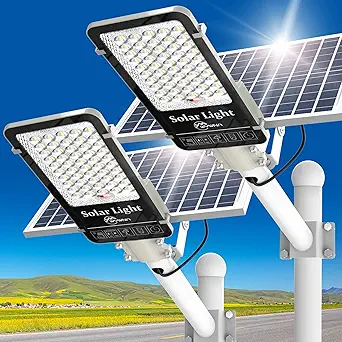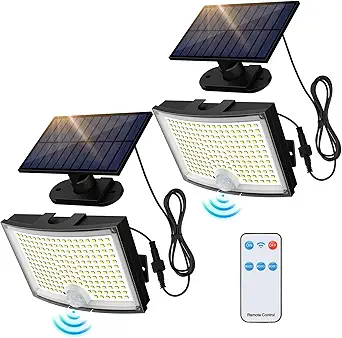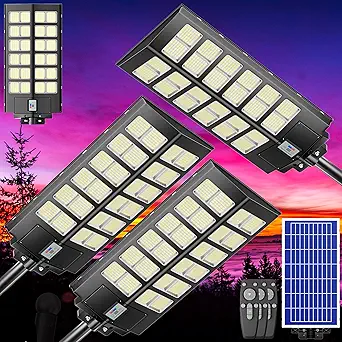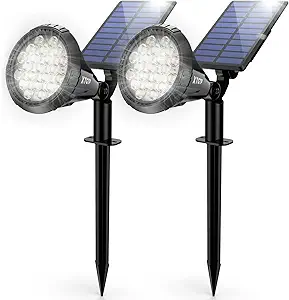Introduction
Solar flood lights are a modern, eco-friendly lighting solution that has gained popularity in recent years. These lights use solar energy, a renewable and sustainable resource, to provide bright illumination for outdoor areas. Whether it’s for home security, illuminating a garden, or lighting up public spaces, solar flood lights are an efficient and cost-effective choice. This guide will explain how solar flood lights work, their benefits, types, installation process, and tips for maintenance, all in simple terms.

What Are Solar Flood Lights?
Solar flood lights are outdoor lighting fixtures powered by solar energy. They are designed to provide broad, intense beams of light over a wide area. These lights consist of three main components:
- Solar Panel: Captures sunlight and converts it into electrical energy.
- Battery: Stores the energy generated by the solar panel during the day.
- LED Light: Emits bright light using the stored energy when it’s dark.
Unlike traditional flood lights that rely on electricity from the grid, solar flood lights are independent and require no wiring, making them easy to install and environmentally friendly.
How Do Solar Flood Lights Work?
Solar flood lights operate on a simple mechanism:
- Daytime Energy Collection: During the day, the solar panel absorbs sunlight and converts it into direct current (DC) electricity. This electricity is stored in the built-in battery.
- Automatic Activation: As the sun sets, the light’s built-in sensor detects the decrease in ambient light and automatically turns on the LED.
- Nighttime Illumination: The LED uses the stored energy to provide illumination throughout the night.
- Recharging Cycle: When the sun rises again, the process repeats, recharging the battery for the next cycle.
Benefits of Solar Flood Lights
- Eco-Friendly:
- Solar flood lights use sunlight, a renewable energy source, reducing carbon emissions.
- They contribute to a cleaner and greener environment.
- Cost-Effective:
- Once installed, they require no electricity, reducing energy bills.
- Minimal maintenance costs make them a long-term economical choice.
- Easy Installation:
- No wiring or electrical expertise is needed.
- They can be installed anywhere with access to sunlight.
- Energy Independence:
- Solar flood lights operate independently of the power grid.
- They are ideal for remote areas or during power outages.
- Durable and Long-Lasting:
- Most solar flood lights use LED bulbs, which have a long lifespan.
- They are built to withstand various weather conditions, including rain and snow.
- Enhanced Security:
- Bright illumination deters trespassers and improves visibility.
- Many models come with motion sensors for added security.

Types of Solar Flood Lights
Solar flood lights come in various designs and features to suit different needs:
- Standard Solar Flood Lights:
- Provide continuous illumination after sunset.
- Ideal for general outdoor lighting, such as gardens or patios.
- Motion Sensor Solar Flood Lights:
- Equipped with sensors that detect movement and activate the light.
- Suitable for security purposes, as they only light up when needed.
- Remote-Controlled Solar Flood Lights:
- Can be turned on/off or adjusted using a remote control.
- Useful for customizable lighting.
- High-Lumen Solar Flood Lights:
- Provide exceptionally bright light, ideal for large areas like parking lots or sports fields.
- All-in-One Solar Flood Lights:
- Compact designs that integrate the solar panel, battery, and light into a single unit.
- Simple to install and maintain.
Where to Use Solar Flood Lights
Solar flood lights are versatile and can be used in various settings, including:
- Residential Areas:
- Illuminate gardens, driveways, and backyards.
- Enhance home security.
- Commercial Spaces:
- Brighten parking lots, warehouses, and entrances.
- Public Areas:
- Light up streets, parks, and community spaces.
- Special Applications:
- Used during events, outdoor gatherings, or camping trips.

How to Choose the Right Solar Flood Light
When selecting a solar flood light, consider the following factors:
- Brightness (Lumens):
- Determine the level of brightness needed based on the area you want to illuminate.
- Battery Capacity:
- A higher battery capacity ensures longer illumination.
- Solar Panel Efficiency:
- Look for high-efficiency panels that can generate more energy even on cloudy days.
- Durability:
- Choose lights with weatherproof and sturdy designs to withstand outdoor conditions.
- Features:
- Consider additional features like motion sensors, adjustable brightness, or remote controls.
- Warranty and Brand Reputation:
- Opt for products from reliable brands with good customer reviews and warranty coverage.
Installation of Solar Flood Lights
Installing solar flood lights is straightforward. Here are the basic steps:
- Choose the Location:
- Select a spot with ample sunlight for the solar panel to absorb energy.
- Mount the Light:
- Use screws and brackets provided with the product to secure the light to a wall, pole, or other surface.
- Position the Solar Panel:
- Adjust the panel’s angle to face the sun directly for maximum efficiency.
- Test the Light:
- Ensure the light functions properly by covering the solar panel to simulate darkness.
Tips for Maintaining Solar Flood Lights
- Clean the Solar Panel:
- Dust and debris can reduce the panel’s efficiency. Clean it regularly with a damp cloth.
- Check the Battery:
- Replace the battery every few years to ensure optimal performance.
- Inspect for Damage:
- Look for cracks or water damage, especially after extreme weather conditions.
- Avoid Obstructions:
- Ensure no shadows or obstacles block sunlight from reaching the panel.
- Store During Extreme Weather:
- If possible, remove and store the lights during harsh winters or storms.
The Future of Solar Flood Lights
As technology advances, solar flood lights continue to improve. Future innovations may include:
- Higher Efficiency Panels: New materials and designs that capture more energy.
- Longer-Lasting Batteries: Improved storage capacity for extended use.
- Smart Features: Integration with smart home systems and apps for better control.
- Sustainable Materials: Eco-friendly materials for increased sustainability.
